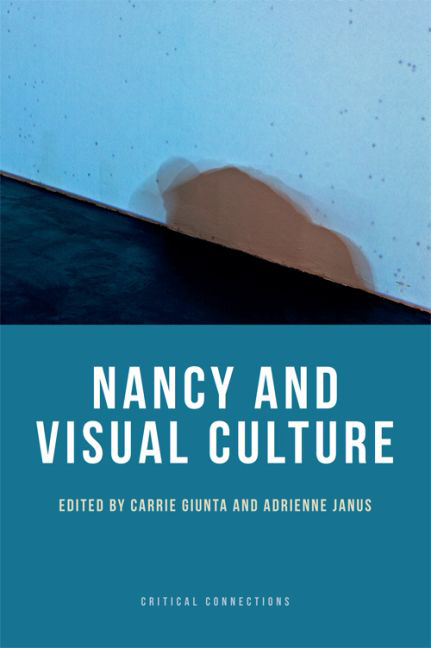Book contents
- Frontmatter
- Contents
- List of illustrations
- Acknowledgements
- Introduction: Jean-Luc Nancy and the Image of Visual Culture
- 1 Cutting and Letting-Be
- 2 Dancing Equality: Image, Imitation and Participation
- 3 A Question of Listening: Nancean Resonance, Return and Relation in Charlie Chaplin
- 4 The Image: Mimesis and Methexis
- 5 On the Threshold: Visual Culture, Invisible Nature
- 6 Pornosophy: Jean-Luc Nancy and the Pornographic Image
- 7 Presentation and Disappearance: Dialogue between Soun-Gui Kim and Jean-Luc Nancy
- 8 Writing in the Place of the Animal
- 9 Together at the Limit: Jean-Luc Nancy, Art and Community
- 10 Turning Around the Written Mark, Opening from a Weight of Thought
- 11 Uncanny Landscapes of Photography: The Partage of Double-Exposure after Jean-Luc Nancy
- Contributors
- Bibliography
- Index
10 - Turning Around the Written Mark, Opening from a Weight of Thought
Published online by Cambridge University Press: 15 September 2017
- Frontmatter
- Contents
- List of illustrations
- Acknowledgements
- Introduction: Jean-Luc Nancy and the Image of Visual Culture
- 1 Cutting and Letting-Be
- 2 Dancing Equality: Image, Imitation and Participation
- 3 A Question of Listening: Nancean Resonance, Return and Relation in Charlie Chaplin
- 4 The Image: Mimesis and Methexis
- 5 On the Threshold: Visual Culture, Invisible Nature
- 6 Pornosophy: Jean-Luc Nancy and the Pornographic Image
- 7 Presentation and Disappearance: Dialogue between Soun-Gui Kim and Jean-Luc Nancy
- 8 Writing in the Place of the Animal
- 9 Together at the Limit: Jean-Luc Nancy, Art and Community
- 10 Turning Around the Written Mark, Opening from a Weight of Thought
- 11 Uncanny Landscapes of Photography: The Partage of Double-Exposure after Jean-Luc Nancy
- Contributors
- Bibliography
- Index
Summary
There is an exscription from writing, as Jean-Luc Nancy explains, ‘that doesn't happen exactly in writing, if writing in fact has an “inside”. But along the border, at the limit, the tip, the farthest edge of writing nothing but that happens’. An exterior and multiple ‘x’ of sorts, this indiscernible limit finds the writer, and more broadly the drawer as well, in a state of exposure. It is a state of physical and mental extremity that I want to look at here, investigating how one tries to inscribe throughout this exteriorising limit.
Sense, a term imperative to the writings of Nancy, often indicates a signifying generated in advance of a text, grapheme, or imprint. Nancy dubs the exteriorising operation exscription. With the ‘ex-’, as in exteriorisation, extension, and exposure, Nancy is thinking of sense as ‘outside’. In exscription, sense is exscribed by touching the body. The body is the exterior act, or means, of opening in advance of anything that otherwise is essentially sense. The body is the exterior act, or the act (means) of opening onto … and in excess of meaning.
Prevalent in textual inscription, as much as in drawing, is the individual effort to display the effect of such a hermeneutical touch. Exscribing touch prompts a trace of thought, so to speak, giving form not merely to thought, but to one of the most singular of bodily effects – weight. Since thinking resonates with weighing, incurs a heaviness and a downward movement, one should question inscription with regards to drawing, since it is by means of drawing that writing turns back, withdraws to a more exscriptive condition of speculation that emphasises the inscriber. The proposition I consider here is that thought is not an essence one comprehends from within a substantial ‘self’, nor visually evidences through an inscribed imprint, or graphic trace. Rather, the aim of my investigation is to explore this essentialist notion of thought, which discards a condition of sense shared by the body, and to move towards thinking as an extremity that is weight ‘exscribed in advance of all writing’.
Exscription turns inscription outward. It obstructs and generates a sense that is otherwise grasped within the visible imprint of a trace.
- Type
- Chapter
- Information
- Nancy and Visual Culture , pp. 181 - 198Publisher: Edinburgh University PressPrint publication year: 2016



